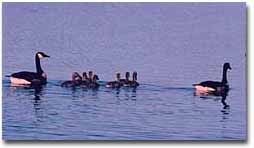 Approximately 90% of the Mt. Nebo WMA is dominated by mixed hardwood forest in various age classes, with the remaining 10% comprised of wetland bog, agricultural fields, and power line rights-of-way. A 1,854 acre tract located in southwestern Garrett County, Mt. Nebo WMA protects two red spruce bogs, one of the most unique wetlands in Maryland. These are among the oldest peat bogs in eastern North America, complete with a host of rare and endangered plants. This wetland thicket complements the young forest habitat that the area is managed to provide.
Approximately 90% of the Mt. Nebo WMA is dominated by mixed hardwood forest in various age classes, with the remaining 10% comprised of wetland bog, agricultural fields, and power line rights-of-way. A 1,854 acre tract located in southwestern Garrett County, Mt. Nebo WMA protects two red spruce bogs, one of the most unique wetlands in Maryland. These are among the oldest peat bogs in eastern North America, complete with a host of rare and endangered plants. This wetland thicket complements the young forest habitat that the area is managed to provide.
What To See
River otters, released in Western Maryland by wildlife biologists, could be seen swimming along the shoreline of the beaver pond or waterfowl impoundment. The drumming sound of the male ruffed grouse and the gobbling of male turkeys are fascinating to hear. Many songbirds migrate to the unique to the wetlands and forests. Birders target this area to find alder flycatchers in the summer months.
What To Do
Mt. Nebo is best known for its excellent ruffed grouse and woodcock hunting. In the fall, a man-made pond, or "impoundment," attracts a variety of migrating waterfowl and provides some hunting opportunity. White-tailed deer, turkey, and black bears are also among the game species. Many trails and old roads invite quiet strolls or challenging hikes and take the visitor to many picturesque landscapes.
Area Regulations
- Use of Mt. Nebo WMA is generally permitted seven days a week throughout the year.
- Hunting is allowed in accordance with open seasons and shooting hours.
- No special permits or drawings are required to hunt this area, except appropriate licenses and stamps.
- Trapping by permit only.
- There is disabled hunter access off of Oakland-Sang Run Road.
Special Areas
- There is disabled hunter access available. One area off of Mt. Nebo Road that leads toward the impoundment is open during the firearm deer season only.
Non-hunting Users Guide
- Non-hunting visitors are welcome
- Be aware of open hunting seasons and visit accordingly
- Season dates available in newspapers, on the Internet, and at some area stores
- Trails are maintained but not actively marked
- Bird watching, hiking and mushroom hunting are popular uses of this area
- Mature hardwood forest and wetlands surround many of the trails and support a rich variety of song birds and other wildlife species, depending on the time of year
- The area has mostly gently rolling topography with some steep slopes and elevations range from 2,400 feet to 2,800 feet
Site Management Goals
- Mt. Nebo WMA is managed to provide habitat for a variety of forest wildlife species that require a diverse forest age structure.
- Wildlife openings are maintained and planted to provide feeding and brood rearing habitat.
- Species that can be found here include: white-tailed deer, ruffed grouse, wild turkeys, cottontail rabbits, squirrels, woodcock, mallard ducks, wood ducks, beaver, muskrats, fisher, raccoons, and numerous non-game species.
- An extensive wetland complex with man-made and beaver impoundments, thick alder and wetland shrub cover, and isolated pockets of red spruce and hemlock stands occurs on the area.
Directions
From I-68 at Keyser's Ridge, take MD 219 south toward Oakland. Mt. Nebo is approximately 3 miles north of Oakland along the west side of MD 219. Access to the area is via parking areas located along Route 219 or Oakland/Sang-run Road. For additional information, contact the Mt. Nebo Wildlife Office at (301) 334-4255.
 Click Here for Map
Click Here for Map
This area is a part of Maryland’s Department of Natural Resources public land system and is managed by the Wildlife and Heritage Service. The primary mission of the WMA system is to conserve and enhance wildlife populations and their respective habitats as well as to provide public recreational use of the State’s wildlife resources.
Eighty-five percent of the funding for Maryland's state wildlife programs comes from hunting license fees and a federal excise tax on sport hunting devices and ammunition. The federal aid funds are derived from the Federal Aid in Wildlife Restoration (or Pittman-Robertson) Fund, which sportsmen and women have been contributing to since 1937. Each state receives a share of the funds, which is administered by the U. S. Fish and Wildlife Service; these funds are used for wildlife conservation and hunter education programs, including the management of the WMA system.
Other sources of funds for land acquisition include Program Open Space Funding for Maryland's State and local parks and conservation areas, provided through The Department of Natural Resources' Program Open Space. Established in 1969, Program Open Space symbolizes Maryland's long-term commitment to conserving natural resources while providing exceptional outdoor recreation opportunities.